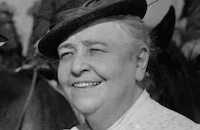Once to Every Woman

Cast & Crew
Lambert Hillyer
Ralph Bellamy
Fay Wray
Walter Connolly
Mary Carlisle
Walter Byron
Film Details
Technical Specs

Synopsis
Twenty-six-year-old Mary Fanshawe, a dedicated, attractive nurse, is the able supervisor of Ward K in a prestigious hospital. Her judgment in matters of the heart is not as sound as her professional acumen, however, for she is in love with the philandering, ambitious Dr. Preston. As a result, she resents the competition that Dr. Jim Barclay, a brilliant surgeon and protégé of elderly Dr. Walter Selby, presents for Preston. Although grateful to Selby for providing him with the opportunity to work at the hospital, Barclay recognizes that Selby's methods are sadly out of date and may be endangering patients. Meanwhile, Doris Andros, a junior nurse, has become the latest object of Preston's attention, and she dwells on him to the detriment of her work. Mary, not knowing of Doris' affair with Preston, upbraids the junior nurse for her lack of dedication. In Mary's ward are a variety of cases, including Julie, who believes she is recovering, but is about to have a leg amputated; Mrs. Flannigan, who loves her husband all the more for having broken six of her ribs; and Gail Drake, a nightclub dancer, who has been scarred by acid thrown by a rival. The most complicated case is that of "Number 16," who suffers from a brain disorder that Selby is treating by an old-fashioned method that, while avoiding the risk of surgery, multiplies the eventual need for it. Barclay proposes a more dangerous operation that offers the possibility of a complete cure. Selby is finally persuaded to let the surgery by scheduled, but as the patient is being prepared for the operation, which only Barclay is qualified to perform, Selby jealously pulls rank and insists on acting as the head surgeon. During the procedure, Selby loses his nerve, and Barclay must push him aside in order to finish the job. Later, Barclay offers to resign rather than further embarrass his superior, but Selby refuses to accept his resignation, and instead indicates that he will retire and name Barclay his successor. Soon after, the despondent Gail drinks alcohol that Doris has carelessly left behind in an attempt at suicide. Although he is on duty, Preston is on the roof with Doris and cannot be found, and Barclay is called upon to save Gail's life. Barclay attempts to shield Preston before Mary, but Doris admits what happened when she quits. Although disillusioned in love, Mary is encouraged by Barclay's expression of admiration, and a new affection stirs her heart.

Director
Lambert Hillyer
Cast

Ralph Bellamy

Fay Wray

Walter Connolly

Mary Carlisle
Walter Byron

J. Farrell Macdonald
Billie Seward
Georgia Caine
Katherine Clare Ward
Mary Foy
Ben Alexander
Rebecca Wassem

Leila Bennett

Jane Darwell
Nora Cecil
Ed Le Saint
Crew

Videos
Movie Clip



Film Details
Technical Specs

Articles
Once To Every Woman
Newly retitled Once to Every Woman, Cronin's story was advertised in print ads with the slogan, "There comes a love so powerful, so elemental, that all about her are enveloped in its consuming flame." The Hollywood treatment clearly added a heavy love element to the medical drama by emphasizing nurse Mary's romance with Dr. Preston. When chief surgeon Dr. Selby nearly kills a patient in brain surgery, Preston's rival, Dr. Barclay saves the day and the patient. Barclay gets the chief surgeon's position when Selby retires, and Mary resents the professional threat he poses to Preston. However, Mary's feelings for Barclay soon change when she learns Preston is cheating on her with another nurse (Carlisle).
Cronin, a former military doctor, had long wanted to be a writer but found he never had the time to start. Fate intervened when he came down with an ulcer and was unable to practice medicine during an extended convalescence, so he used that time to write his first novel, 1931's Hatter's Castle, which was so successful that it was translated into five languages and would later be adapted for the screen in England under the title A.J. Cronin's Hatter's Castle (1942), starring Deborah Kerr, James Mason and Robert Newton. Cronin mostly specialized in medical dramas and several of his short stories and novels were adapted for the screen and later television, including, most famously, The Citadel (1938) starring Robert Donat, the Carole Lombard nurse drama Vigil in the Night (1940) and The Keys of the Kingdom (1944) with Gregory Peck.
Once to Every Woman was shot quickly and cheaply (as were most Columbia pictures) in only three weeks, from November 13th to December 4, 1933. It previewed and then went into wide release in the United States in March 1934. Variety, called it "An attempt to crash the hospital cycle and steal the thunder of Men in White [the 1934 Clark Gable, Myrna Loy film] which must await release until the legit play runs its course. This is a programmer which won't make the grade in key houses. Pretty heavy all the way through and insufficient break-up of the story with comedy. Yarn is not a bad one and it all works (as is true of Men in White) to a central surgical operation scene. [...] It's a bit silly to think that could be done and nothing said by anyone, but it looks pretty effective on the screen. [...] Cast is good all around, with Hillyer's direction commendable."
Mary Carlisle, playing the cheating nurse Doris Andros, was the last surviving cast member and one of the last surviving actors of Hollywood's Golden Era, passing away in August 2018 at the age of 104.
By Lorraine LoBianco

Once To Every Woman
Quotes
Trivia
Notes
A. J. Cronin's short story also appeared in a collection published in Berlin in 1938.














